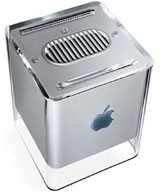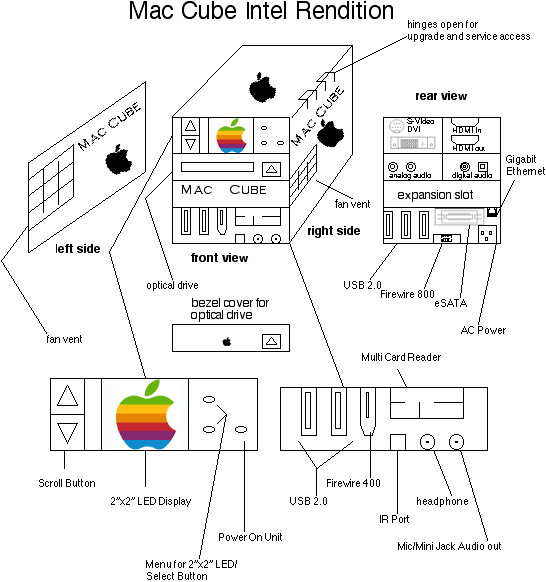Intriguing Design
 Back
in 2000, when Apple released the 450/500 MHz Power Mac G4 Cube,
everyone was astounded by the imaginative case design and the ability
to later upgrade the unit with faster graphics cards, processors, and
more. These upgrades are still available, and with a maxed out G4 Cube,
you have a very capable system even in today's demanding computing
world.
Back
in 2000, when Apple released the 450/500 MHz Power Mac G4 Cube,
everyone was astounded by the imaginative case design and the ability
to later upgrade the unit with faster graphics cards, processors, and
more. These upgrades are still available, and with a maxed out G4 Cube,
you have a very capable system even in today's demanding computing
world.
Value Equation and 'Road Apple' Rating
Alas, the cons outweighed the pros. With the price tag being the
biggest detractor, and with other factors proving competing G4 units to
be better values, the Cube eventually faded away to obscurity, yet it
is still highly regarded as a collector's item. The Cube was truly a
case of a great concept, but not so great execution. Low End Mac's Dan
Knight explains it best in his post-mortem analysis of the G4 Cube in
his Road Apple review.
Why Bring It Back?
If the Cube was such a failure, why bring it back? The logic this
time around is not that hard to consider - correct the shortcomings of
the G4 version and wow consumers with a great price!
Macintosh enthusiasts have always longed for an upgradeable Mac with
the initial power of an iMac
without the display. The Mac
mini comes close but really is more comparable to a desktop version
of a MacBook, rather
than an iMac, without a display. The mini comes with a nice price tag,
but it lacks much hot rodding potential.
Intel Cube Potential
With a case design and footprint similar to the Mac mini, but just
slightly larger and taller (approximately 8" cubed, in the spirit of
the original), think about what could be done with an Intel Cube. A Mac
mini has plenty packed into a 6.5" square, just 2" high! Imagine how
much more could be packed into a device that was 6" taller?

Re-imagined Mac Cube
Imagining...
This Intel Cube could have an available short length PCI Express
Graphics slot (for special graphics cards similar to the G4 Cube
solutions). This time, there would even be one expansion slot available
(for USB 3.0 or other future expansion possibilities), a tray loading
optical drive (maybe Blu-ray finally) up
front, a 3.5" hard drive bay for a 1 TB SATA hard drive or a 256 GB SSD
(solid state drive), and ports on the rear and front for easy
access.
The rear ports would include HDMI (1 input, 1 output), dual-link DVI
out, S-video out, gigabit ethernet, analog and digital audio out
options, 3 USB 2.0, 1 eSATA, 1 FireWire 800, and a power input. The
front ports would include 2 USB 2.0, 1 FireWire 400, 1 1 IR port,
headphone output, mic/mini jack audio out, and a built-in memory card
reader. Internal Bluetooth 2.1 and AirPort Extreme wireless N would be
standard.
Versatility and Upgrading
This machine would be your home entertainment server, editing
studio, game console, production machine, and more. It would fit nicely
into your entertainment center, like a Mac mini, but just a bit taller,
and it would drive your HDTV with ease using its high-end graphics
solution designed to run cool enough and fit inside the Cube. It would
also work nicely on a desktop with a multitude of monitors. Adapters
such as DVI-to-Component Video, and DVI-to-VGA for other monitor
options would be available.
The HDMI input on the device would allow you to take your cable box
and capture live HDTV, turning the new Mac Cube into your own DVR.
These recordings would be converted directly to iTunes 9 for later
playback or could be re-encoded for playback on an iPhone, iPod touch,
or PSP.
The new Cube would have incredible upgrade potential with a logic
board designed to accept new processor cards, such as the new quad-core
Intel i7 Mobile as a build-to-order option or future upgrade. Again,
the graphics could be upgraded with short length cards, and with the
available expansion slot, there would be many more tricks this Cube
could do compared to its ancestor.
Gaming Potential
In addition to the graphics card upgrades, a new Apple Remote with
gyroscope and accelerometer could become available simultaneously,
along with an Apple-branded gaming controller with intense force
feedback features designed to work with the newest games.
The Apple Gaming Controller would also work as a standard controller
on any other Mac with an IR receiver (USB options are available for
those that don't have a built-in receiver) and would come in a variety
of colors as a throwback to the iMac and iBook colors of yesteryear.
Universal drivers would be available for Input Sprocket, and the
controller would even work in OS 9, making it the ultimate Mac
gaming controller!
Build-to-Order Options
An Apple-branded wireless keyboard with built-in track pad would be
a nice option. It would be like having a desktop with a laptop
controller.
A built-in over-air HDTV receiver would also be a welcome option and
could be controlled through iTunes. This would give you access to HDTV
without a cable box and without a third-party solution. It would be
perfect if you didn't need cable TV or satellite and you had an older
HDTV without a built-in over-the-air receiver. It would also be nice
for the office where you may not have access to a TV, but want to take
a break and just watch the news on your monitor.
RAM could start with 2 GB and be expandable to 8 GB (theoretically
more with larger modules) on these machines using two slots.
An entry-level PCI-Express graphics card would be standard equipment
- or for those who don't need a dedicated graphics solution, but desire
the versatility of the Mac Cube, an integrated Nvidia graphics solution
would be available, leaving the PCI-Express graphics slot open for
later. In addition, state of the art high-end graphics solutions built
for heavy 3D gaming would also be available for a premium.
Hopefully Blu-ray will arrive as an option with the Intel Cube,
giving you access to even more HD content.
Design
The Intel Cube would come in a translucent 9" cube case (enclosing
the 8" cube unit) with a white polycarbonate enclosure around the
hardware itself. Inside the unit and built into the front of the
translucent enclosure would be a tiny LCD display. The LCD, perhaps the
same 2.5" 320 x 240 one used in the iPod classic, could simulate a
glowing backlit Apple logo (this could be toggled on or off).
The backlit Apple logo could be displayed in solid metallic,
original rainbow Apple, or a multitude of other color configurations
and special effects, lighting up the translucent case with a glow and
giving the unit a truly futuristic look.
The built-in LCD could also be set to display your current iTunes
playlist or library, and you could scroll up or down with your Apple
remote or gaming controller to change the song or movie you are
listening to or watching.
Pricing, Savings, and Advantages Over an All-in-One
The unit configured with integrated graphics, lowest processor
speed, 250 GB hard drive, 2 GB of RAM, and no remote, mouse,
keyboard, or controller could retail for $799 - the same price as a
slightly upgraded Mac mini. This would be perfect for someone who
didn't have the money up front (the Mac Pro - the only Mac that uses
standard graphics cards - starts at $2,499!) but wanted to upgrade
later.
If you wanted to max it out right away, an Intel Cube configured
with the fastest available processor, 4 GB of RAM, a 1 TB
hard drive, built-in over-the-air HDTV receiver, wireless
mouse/trackpad combo, new Apple remote, Apple gaming controller, and
best available video card would retail for $1,599 - still roughly
$1,000 less than a 24" iMac or quad-core Mac Pro with the same
features.
Either way, you would have plenty of money left over for your
monitor of choice when compared to the cost of an iMac, plus you would
be able to upgrade it even further down the road!

Dan Bashur lives in central Ohio with his wife and children. He uses various PowerPC G3 and G4 Macs running Tiger and Leopard. Besides finding new uses for Macs and other tech, Dan enjoys writing (fantasy novel series in the works), is an avid gamer, and a member of Sony's Gamer Advisor Panel. You can read more of Dan Bashur's work on ProjectGamers.com, where he contributes regular articles about the PSP, classic gaming, and ways you can use Sony gaming hardware with your Mac.

 Back
in 2000, when Apple released the
Back
in 2000, when Apple released the 

